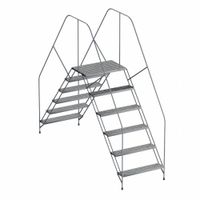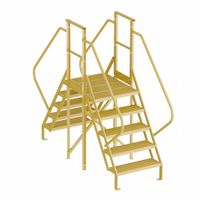Call +(254) 703 030 000 / 751 483 999 / 721 704 777
- Home
- Material Handling
- Ladders Platforms Personnel Lifts
- Ladders
- Crossover Ladders Bridges
.....Read More
Frequently Asked Questions
What are crossover ladders used for?
Crossover ladders are specialized ladders designed to provide safe passage over obstacles such as pipes, conveyors, or other equipment in industrial and commercial settings. They are used to ensure that workers can move efficiently and safely across areas that would otherwise be difficult or hazardous to navigate. These ladders typically feature a platform at the top, handrails, and steps on either side, allowing for easy ascent and descent.
The primary purpose of crossover ladders is to enhance workplace safety by minimizing the risk of trips, falls, and other accidents that could occur when attempting to step over obstacles without proper support. They are commonly used in factories, warehouses, and construction sites where space is limited and equipment or machinery may obstruct pathways.
Crossover ladders are often constructed from durable materials such as aluminum, steel, or fiberglass to withstand heavy use and harsh environmental conditions. They are designed to be stable and secure, with non-slip surfaces and sturdy handrails to provide additional support for users.
In addition to safety, crossover ladders contribute to operational efficiency by allowing workers to move quickly and easily between different areas of a facility without having to detour around obstacles. This can be particularly important in environments where time is critical, such as in manufacturing or logistics operations.
Overall, crossover ladders are an essential tool in maintaining a safe and efficient work environment, enabling workers to perform their tasks without unnecessary risk or delay.
How do you install a crossover ladder?
1. **Site Assessment**: Determine the location and ensure the surface is level and stable. Check for any obstructions or hazards.
2. **Select the Ladder**: Choose a crossover ladder that meets the height and width requirements for the area it will span. Ensure it complies with safety standards.
3. **Gather Tools and Materials**: You will need a drill, appropriate drill bits, wrenches, bolts, nuts, washers, and any other hardware specified by the manufacturer.
4. **Prepare the Area**: Clear the installation site of debris. Mark the positions where the ladder will be anchored.
5. **Assemble the Ladder**: Follow the manufacturer’s instructions to assemble the ladder. This typically involves connecting the steps, handrails, and platform.
6. **Position the Ladder**: Move the assembled ladder to the installation site. Ensure it is aligned correctly over the obstacle it is meant to cross.
7. **Anchor the Ladder**: Drill holes into the surface at the marked positions. Use bolts, nuts, and washers to secure the ladder to the ground or structure. Tighten all connections firmly.
8. **Check Stability**: Ensure the ladder is stable and does not wobble. Adjust as necessary to achieve a secure fit.
9. **Install Safety Features**: Attach any additional safety features such as toe boards, guardrails, or non-slip treads if not already included.
10. **Inspect the Installation**: Conduct a thorough inspection to ensure all components are securely fastened and the ladder is safe for use.
11. **Test the Ladder**: Carefully test the ladder by walking over it to ensure it supports weight and functions as intended.
12. **Maintenance Plan**: Establish a regular maintenance schedule to check for wear and tear, ensuring long-term safety and functionality.
What materials are crossover ladders made from?
Crossover ladders are typically made from materials such as aluminum, steel, and fiberglass.
1. **Aluminum**: This is a popular choice due to its lightweight nature, corrosion resistance, and durability. Aluminum crossover ladders are easy to maneuver and install, making them ideal for environments where mobility is important. They are also resistant to rust, which is beneficial in outdoor or humid conditions.
2. **Steel**: Steel crossover ladders are known for their strength and robustness. They are often used in industrial settings where heavy-duty applications are required. Steel ladders can support higher weight capacities and are more resistant to physical damage. However, they are heavier and may require protective coatings to prevent rust and corrosion.
3. **Fiberglass**: Fiberglass is an excellent choice for environments where electrical safety is a concern, as it is non-conductive. Fiberglass crossover ladders are also resistant to weathering, chemicals, and UV radiation, making them suitable for both indoor and outdoor use. They are generally more expensive than aluminum or steel options but offer superior safety features in certain applications.
Each material has its advantages and is chosen based on the specific requirements of the environment in which the crossover ladder will be used.
Are crossover ladders adjustable?
Yes, crossover ladders are adjustable. These ladders are designed to provide safe passage over obstacles such as pipes, conveyors, or other obstructions in industrial and commercial settings. The adjustability of crossover ladders typically refers to their height, width, and sometimes the angle of the steps or platform.
Adjustable features allow these ladders to be customized to fit specific site requirements, ensuring they can be used in various environments and applications. The height can often be modified to accommodate different clearance needs, while the width can be adjusted to fit the space available. Some models also offer adjustable handrails and platform lengths to enhance safety and usability.
The materials used in crossover ladders, such as aluminum, steel, or fiberglass, contribute to their durability and adaptability. These materials are chosen for their strength, resistance to corrosion, and ability to withstand harsh environmental conditions.
In summary, the adjustability of crossover ladders makes them versatile tools in ensuring safe and efficient movement over obstacles in diverse settings.
How do you ensure the safety of crossover ladders?
To ensure the safety of crossover ladders, follow these guidelines:
1. **Design and Material**: Choose ladders made from durable materials like aluminum or steel, ensuring they meet industry standards. The design should include non-slip surfaces and handrails for stability.
2. **Installation**: Install ladders on a stable, level surface. Secure them properly to prevent movement. Ensure the installation complies with OSHA or relevant safety regulations.
3. **Inspection**: Regularly inspect ladders for damage, wear, or corrosion. Check for loose bolts, cracks, or any structural weaknesses. Address any issues immediately.
4. **Load Capacity**: Adhere to the manufacturer's specified load capacity. Ensure the ladder can support the weight of users and any additional equipment.
5. **Training**: Provide comprehensive training for users on proper usage, including climbing techniques and safety protocols. Emphasize the importance of maintaining three points of contact.
6. **Signage**: Use clear signage to indicate weight limits, usage instructions, and potential hazards. Ensure signs are visible and legible.
7. **Maintenance**: Implement a regular maintenance schedule. Clean ladders to remove debris or substances that could cause slipping. Lubricate moving parts as needed.
8. **Access Control**: Restrict access to authorized personnel only. Use barriers or locks if necessary to prevent unauthorized use.
9. **Emergency Procedures**: Establish and communicate emergency procedures in case of accidents. Ensure first aid kits and emergency contacts are readily available.
10. **Lighting**: Ensure adequate lighting around the ladder area to prevent accidents during low visibility conditions.
By adhering to these practices, you can significantly enhance the safety of crossover ladders, minimizing the risk of accidents and ensuring a secure working environment.
What are the weight limits for crossover ladders?
Crossover ladders, designed for safe passage over obstacles, typically have weight limits that vary based on their construction and intended use. Generally, these ladders are built to support weights ranging from 300 to 800 pounds. The specific weight limit depends on factors such as the materials used (aluminum, steel, or fiberglass), the ladder's design, and its intended industrial or commercial application.
For industrial-grade crossover ladders, which are often used in environments like factories or warehouses, the weight capacity is usually on the higher end, around 500 to 800 pounds. These ladders are constructed to withstand heavy-duty use and accommodate the weight of workers carrying tools or equipment.
Commercial-grade crossover ladders, used in less demanding environments, might have weight limits closer to 300 to 500 pounds. These are suitable for lighter tasks and environments where the ladder is not subjected to extreme conditions.
It's crucial to adhere to the manufacturer's specified weight limits to ensure safety and prevent accidents. Overloading a crossover ladder can lead to structural failure, posing significant risks to users. Always check the ladder's specifications and ensure it meets the requirements of your specific application.
Can crossover ladders be customized for specific needs?
Yes, crossover ladders can be customized for specific needs. Customization options include:
1. **Dimensions**: The height, width, and length of the ladder can be adjusted to fit specific spatial requirements or to bridge particular obstacles.
2. **Material**: Depending on the environment, materials such as aluminum, steel, or fiberglass can be chosen for durability, weight, and resistance to elements like corrosion or electricity.
3. **Load Capacity**: Ladders can be designed to support varying weight capacities, accommodating different types of equipment or personnel.
4. **Tread Design**: The steps can be customized with different tread patterns or materials to enhance grip and safety, especially in environments prone to moisture or oil.
5. **Handrails and Guardrails**: These can be added or modified to meet safety standards or user preferences, ensuring secure passage.
6. **Platform Size**: The platform area at the top of the ladder can be expanded or reduced based on the space needed for operations or equipment placement.
7. **Mobility Features**: Wheels or casters can be added for easy relocation, or the ladder can be fixed in place for stability.
8. **Access Points**: The number and location of access points can be customized to facilitate entry and exit from different directions.
9. **Finish and Coating**: Protective coatings or finishes can be applied to enhance durability and resistance to environmental factors.
10. **Compliance**: Ladders can be designed to meet specific industry standards or regulations, such as OSHA or ANSI requirements.
These customizations ensure that crossover ladders meet the unique operational, safety, and environmental needs of various industries.

